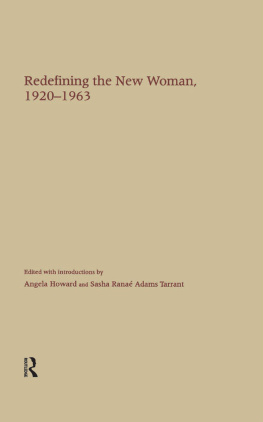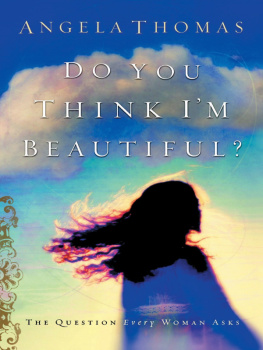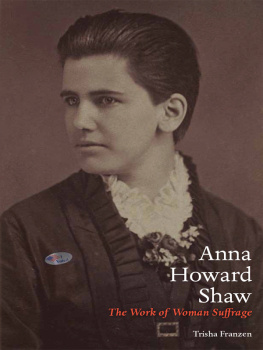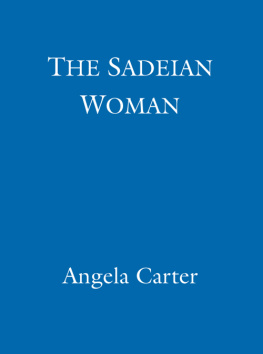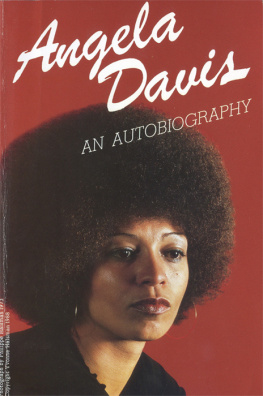Antifeminism in America
A Collection of Readings from the Literature of the Opponents to U.S. Feminism, 1848 to the Present
Series Editors
Angela Howard and Sasha Rana Adams Tarrant
University of Houston Clear Lake
Contents of the Series
1. Opposition to the Womens Movement in the United States, 18481929
2. Redefining the New Woman, 19201963
3. Reaction to the Modern Womens Movement, 1963 to the Present
Redefining the New Woman, 19201963
Edited with introductions by
Angela Howard and Sasha Rana Adams Tarrant
University of Houston Clear Lake
First published 1997 by Garland Publishing, Inc.
Published 2019 by Routledge
2 Park Square, Milton Park, Abingdon, Oxon OX14 4RN
52 Vanderbilt Avenue, New York, NY 10017
Routledge is an imprint of the Taylor & Francis Group, an informa business
Introductions Copyright 1997 Angela Howard and Sasha Rana Adams Tarrant
All rights reserved. No part of this book may be reprinted or reproduced or utilised in any form or by any electronic, mechanical, or other means, now known or hereafter invented, including photocopying and recording, or in any information storage or retrieval system, without permission in writing from the publishers.
Notice:
Product or corporate names may be trademarks or registered trademarks, and are used only for identification and explanation without intent to infringe.
Library of Congress Cataloging-in-Publication Data
Redefining the new woman, 19201963 / edited with introductions by Angela Howard and Sasha Rana Adams Tarrant.
p. cm. (Antifeminism in America ; 2)
Includes bibliographical references.
ISBN 0-8153-2714-5 (vol. 2 : alk. paper). ISBN 0-8153-2712-9 (3 vol set : alk. paper)
1. Anti-feminismUnited States. 2. FeminismUnited States. 3. WomenUnited StatesSocial conditions. I. Howard, Angela. II. Tarrant, Sasha Rana Adams. III. Series.
HQ1426.R417 1997
305.420973dc21 | 97-38206 CIP |
ISBN 13: 978-0-8153-2714-1 (hbk)
Contents
Clara Mortenson Beyer
Henry Ford
Anthony Bertram
Guion Griffis Johnson
Reginald F. Rynd
Anne W. Armstrong
Ethel M. Johnson
John Macy
Gina Lombroso Ferrero
Iona Mure
Anthony M. Ludovici
Margaret G. Bondfield
Joseph Collins
Anthony M. Ludovici
Hugh L. McMenamin
John Leonard Cole
Henry R. Carey
Ruby A. Black
Ruth Allison Hudnut
D.H. Lawrence
Eleanor B. Saunders
Creighton Peet
Marjorie Wells
Albert Jay Nock
Bernard Acworth and Muriel Kirkpatrick
D.P.H.
Nirgidma de Torhout
Ernest R. Groves
S.H. Halford
S.H. Halford
S.H. Halford
Frances Levinson
Irene M. Josselyn and Ruth Schley Goldman
Evelyn Ellis
Priscilla Robertson
Mervin B. Freedman
Adlai E. Stevenson
David Riesman
Orville G. Brim Jr.
Norman Mailer
Understanding the Opposition to U.S. Feminism
The purpose of this three-volume collection of primary sources is to generate a more complete understanding and appreciation of the social and political context in which the advocates of womens rights have labored and labor from 1848 to the present. The editors have selected original documents from mainstream literature to allow the reader immediate access to this continuing public discourse that accompanies the prospective and the real changes in womens role and status in the United States. Those opposed to the feminist goal of womens equality have addressed to the public, directly through contemporary popular books and magazines, their concerns regarding the particular nineteenth-century issues of the womans rights movement. These include woman suffrage and dress reform, as well as topics relating to the discerning and enforcing the proper role and status of women. Public discourse over such topics has extended into the twentieth century, as opponents raised arguments against increased opportunities in womens employment and education, denied the propriety and practice of family planning, and admonished against womens involvement in political issues and activities. In these three volumes, the opponents of feminism speak directly to the reader who is free to evaluate the merits of each authors arguments.
Diversity of opinion and perspective has persisted among those who oppose the assertion of womens rights as reform movement, which challenges the concepts and institutions of patriarchy as well as the gender system that supports and perpetuates a gender-defined, limited, and segregated existence for women. The constellation of conservative definitions of proper womanhood has varied widely in approach, intent, and intensity. Over the past two-hundred years the critics of feminism, of advances in womens rights, and of the increased opportunity in education and employment for women have had to absorb changes in the status of middle-class women. These critics therefore have co-opted and redefined some of the fait accompli changes to maintain that contemporary practices uphold the primary limitation for women in any century, that for women biology is destiny. All these opponents to sexual equality ultimately assert that an inescapable maternal duty grounds every womans identity in her relationships to others and especially to men: each womans usefulness to society through filial, uxorial, maternal, professional, and civic responsibilities define and limit her identity as an individual.
Some opponents merely dismissed or ridiculed advocates for changes in womens status, and eschewed the need to specify particular flaws in the feminist position on any particular issue. Others relied on interpretations of divine ordination, appeals to natural law, and manipulations of public fears of familial and social disintegration. Often opponents sought to discredit the propriety or to challenge the necessity of any change in the gender system proposed by advocates of womens rights. They utilized divisive tactics to separate women by race or ethnic group, religion, or economic class. Frequently, these critics resorted to ad hominum charges of lesbianism, communism, and socialism, or disgruntled spinsterhood against the advocates of womens rights and against the movement itself. Opponents defined the effort to promote the womens movement out of the domestic sphere and into the public arena of political, economic, and social reform as inherently destructive of social order. By focusing on maintaining a limited role for women, adversaries of the womens movement, both women and men, expressed their common fear that has been created by ongoing social, economic, and political changes beyond their control.
Therefore, much of the value in reading these sources is to experience the variety of perspectives that provide the historical and intellectual context for these documents from the distant and near past. The editors offer this varied selection of sources to allow the reader to assess the merit and validity of the arguments presented by these representative opponents of womens rights and equality. Not all opponents of specific feminist reforms would define themselves as antifeminist; most would deny that they are anti-woman, although opposed to expanding womens rights. For the student of womens history, the temptation to look for patterns of opposition will become irresistible. To facilitate an evaluation of the texts in their own historical context, the editors have grouped the documents within three major historical periods. Because the sources of mainstream opponents were more readily available, we elected to focus on the debate among writers who represented the middle class and who exerted a presence in the popular press. Especially for students of American womens history, this collection provides the opportunity to encounter directly the opinions of those who resisted and criticized the goals as well as the tactics of feminism in all its forms.


